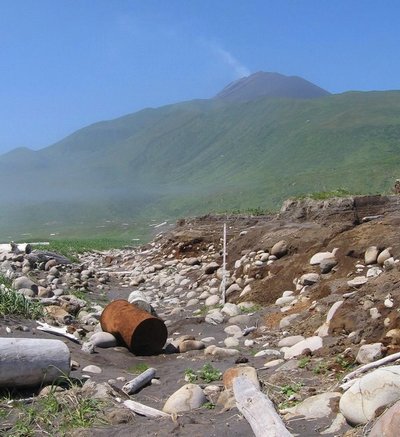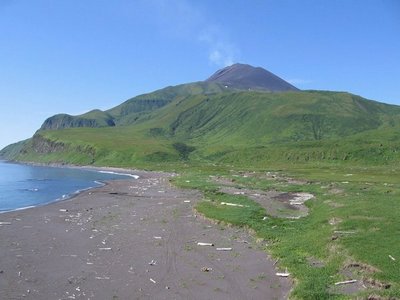October 27, 2009
Fortuitous research provides first detailed documentation of tsunami erosion
Tsunamis are among the most-devastating natural calamities. These earthquake-generated waves can quickly engulf low-lying land and bring widespread destruction and death. They can deposit sand and debris far inland from where they came ashore.
Now, for the first time, a group of scientists working in the Kuril Islands off the east coast of Russia has documented the scope of tsunami-caused erosion and found that a wave can carry away far more sand and dirt than it deposits.
The fortuitous observations resulted because the Kuril Biocomplexity Project had made detailed surveys of some Kuril Island coastlines during the summer of 2006, and then returned for additional work in the summers of 2007 and 2008. That provided a unique opportunity for before-and-after comparisons following a magnitude 8.3 earthquake and accompanying tsunami on Nov. 15, 2006, and an 8.1 quake and resulting tsunami on Jan. 13, 2007.
When the scientists revisited coastlines they had surveyed in 2006, they found that in some places the amount of sand and soil removed by tsunami erosion was nearly 50 times greater than the amount deposited.
“It was so extreme. I was really surprised,” said Breanyn MacInnes, a University of Washington doctoral student in Earth and space sciences.
The team observed shorelines stripped of vegetation, small hills of soil and volcanic cinders washed away to expose boulders and, in one place, the unearthed rusty remnants of military equipment left behind at the end of World War II.
“We were there the year before and it had been completely covered with vegetation, and there were ridges closer to shore that had been completely removed when we returned,” MacInnes said.
She is the lead author of a paper describing the observed differences in erosion and deposition, published in the November issue of the journal Geology. Co-authors are Joanne Bourgeois, a UW professor of Earth and space sciences and MacInnes’ doctoral adviser, and Tatiana Pinegina and Ekaterina Kravchunovskaya of the Far East Branch of the Russian Academy of Sciences. The work was funded by the National Science Foundation and the Russian Academy of Sciences Institute of Marine Geology and Geophysics.
The Nov. 15, 2006, Kurils earthquake was large enough to raise alarms about the potential for a tsunami throughout the Pacific basin. Only very tiny waves were recorded on the Japanese island of Hokkaido, relatively near the Kurils. However, a tsunami nearly 6 feet high did more than $10 million damage to the harbor at Crescent City, Calif., some 4,500 miles away.
The Kurils themselves were hit by tsunami waves more than 70 feet high in some places, and changes in topography were dramatic.
The amount of erosion from a tsunami depends somewhat on the topography of the land, but definitely is related to the force of the wave, the scientists found. They noted that an area called South Bay on Matua Island lost about 50 cubic meters, or about 1,765 cubic feet, of sediment per meter of width, while an area called Ainu Bay lost an astounding 200 cubic meters, or about 7,060 cubic feet, of sediment per meter of width because of tsunami-induced erosion.
At a spot called Dushnaya Bay, where the tsunami was at a relatively low elevation at its greatest distance from shore, the biggest change occurred on the sandy beach, with about 5 cubic meters, or about 177 cubic feet, of sediment eroded per meter of width.
In other areas, relatively fine volcanic sand from the shore and much coarser volcanic cinders unearthed from ridges were deposited well inland, but the amount of sediment deposited was far less than the amount eroded, the researchers found.
Some of the landscape scars will remain visible for decades, or even centuries, the scientists reported. For example, along Ainu Bay ridges were removed, depressions were scoured into the topography and a lake was breached and drained.
“One thing we really noticed was that anywhere there had been human disturbance, like the remnants of a military base or even just a fencepost, there was always some sort of blowout or deeper erosion,” MacInnes said.
She noted that geologists have long considered erosion to be an important factor in studying tsunamis.
“There are a lot of papers that describe erosion but they can’t really quantify it. Our study is the first to say, ‘This much sand was removed from the coast,'” she said.
“This emphasizes that erosion is something to consider when assessing a community’s risks and vulnerability.”
###
For more information, contact MacInnes at 206-437-2659, 206-543-6686 or macinneb@uw.edu.


